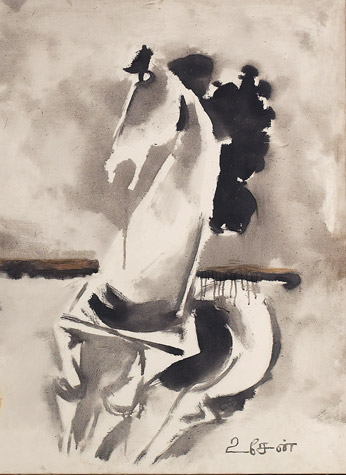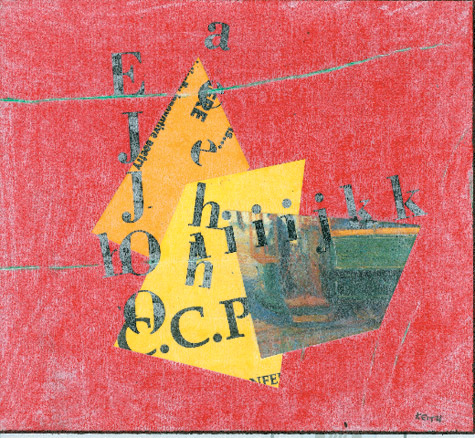
ABSTRACT SIMPLIFICATIONS Husain’s Chariot. |
Maqbool Fida Husain has long been known as one of the grand old men of Indian art. The New York Times refers to the 94-year-old as "India's most famous painter" and one of the "great Indian modernists." In recent years, his notoriety has taken a cruel twist as Hindu nationalists, offended by Husain's nude depictions of Hindu goddesses, have brought obscenity cases against him and attacked his home. The artist, a Muslim, took refuge in Dubai — though there is talk that things may have cooled enough that he is now considering returning home.
"M.F. Husain: Early Masterpieces, 1950s-'70s," at Brown University's Pembroke Hall (172 Meeting Street, Providence, through March 26), is a rare opportunity to see his early works, since modern and contemporary Indian art is still little exhibited in the United States. What you learn is that Husain may be a great man, but he's not a great artist.
In 1947, the year India won independence from Britain, Husain was one of six artists who founded India's Progressive Artists' Group, opening up traditional Indian painting by finding inspiration in European modern art. Husain was particularly taken with Picasso and, as seen in this exhibit, produced Cubist-inspired paintings featuring traditional Indian Hindu subjects — the god Krishna, the goddess Durga, the god Ganesha, and Draupadi, the heroine of the epic Mahabharata.
The 12 canvases here, all borrowed from the collection of 1991 Brown alum Amrita Jhaveri, date from 1954 to 1971. Husain adopts Cubism's surface look — its simplifications — in paintings like Musicians (1961), which apparently depicts a blue Krishna in a close huddle with two naked women underneath a brown full moon. The abstracted figures are painted in single colors — yellow, blue, or brown — dragged over a brown background. Draupadi (1971) is a muddy schematic painting of the nude heroine with five little blue men, her husbands, perched on her limbs.
Husain comes across as derivative as he continues to pursue Cubism more than five decades after its birth, though in fairness the major American Abstract Expressionists only broke out of Cubism and into their own in the late 1940s. The real problem is that Husain's Cubist abstraction is generic. Great Cubist works crackle with fresh, new ways of thinking about vision and space in art, or they use Cubist distortions to distill powerful feelings (like Picasso's Guernica). Husain's dimunitions tend toward the bland, simplistic, rote.
His sharpest painting here is Black Hill (1964), which depicts a pair of dense, gnarly trees against fierce yellow, red, and blue stripes of sky. The difference is how specifically he envisions the trees, and then how vigorously he paints them.

AMUSING DIVERSIONS An untitled collage by Waldrop. |
Providence poet Keith Waldrop was regarded as a major writer — as well as translator, Brown teacher for four decades, and publisher, with his wife Rosmarie, of Burning Deck Press — long before his book Transcendental Studies: A Trilogy won the National Book Award last year. A selection of 60 collages, spanning many years, now at AS220's Project Space (93 Mathewson Street, Providence, through February 27), reveals his artistic side.